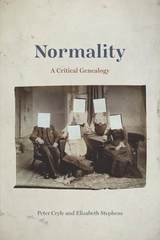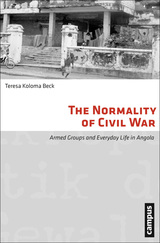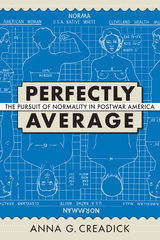4 books about Normality

Murder Scenes
Normality, Deviance, and Criminal Violence in Weimar Berlin
Sace Elder
University of Michigan Press, 2010
"Sace Elder has exhaustively researched both newspaper and other popular and professional treatments of murder cases and archival sources of police investigations and trials in Berlin between 1919 and 1931. Murder Scenes is an innovative and insightful exploration of the ways in which these investigations and trials, and the publicity surrounding them, reflected and shaped changing notions of normality and deviance in Weimar-era Berlin."
---Kenneth Ledford, Case Western Reserve University
---Kenneth Ledford, Case Western Reserve University
Using police reports, witness statements, newspaper accounts, and professional publications, Murder Scenes examines public and private responses to homicidal violence in Berlin during the tumultuous years of the Weimar era. Criminology and police science, both of which became increasingly professionalized over the period, sought to control and contain the blurring of these boundaries but could only do so by relying on a public that was willing to participate in the project. These Weimar developments in police practice in Berlin had important implications for what Elder identifies as an emerging culture of mutual surveillance that was successful both because and in spite of the incompleteness of the system police sought to construct, a culture that in many ways anticipated the culture of denunciation in the Nazi period. In addition to historians of Weimar, modern Germany, and modern Europe, German studies and criminal justice scholars will find this book of interest.
Sace Elder is Associate Professor of History at Eastern Illinois University.
[more]

Normality
A Critical Genealogy
Peter Cryle and Elizabeth Stephens
University of Chicago Press, 2017
The concept of normal is so familiar that it can be hard to imagine contemporary life without it. Yet the term entered everyday speech only in the mid-twentieth century. Before that, it was solely a scientific term used primarily in medicine to refer to a general state of health and the orderly function of organs. But beginning in the middle of the twentieth century, normal broke out of scientific usage, becoming less precise and coming to mean a balanced condition to be maintained and an ideal to be achieved.
In Normality, Peter Cryle and Elizabeth Stephens offer an intellectual and cultural history of what it means to be normal. They explore the history of how communities settle on any one definition of the norm, along the way analyzing a fascinating series of case studies in fields as remote as anatomy, statistics, criminal anthropology, sociology, and eugenics. Cryle and Stephens argue that since the idea of normality is so central to contemporary disability, gender, race, and sexuality studies, scholars in these fields must first have a better understanding of the context for normality. This pioneering book moves beyond binaries to explore for the first time what it does—and doesn’t—mean to be normal.
In Normality, Peter Cryle and Elizabeth Stephens offer an intellectual and cultural history of what it means to be normal. They explore the history of how communities settle on any one definition of the norm, along the way analyzing a fascinating series of case studies in fields as remote as anatomy, statistics, criminal anthropology, sociology, and eugenics. Cryle and Stephens argue that since the idea of normality is so central to contemporary disability, gender, race, and sexuality studies, scholars in these fields must first have a better understanding of the context for normality. This pioneering book moves beyond binaries to explore for the first time what it does—and doesn’t—mean to be normal.
[more]

The Normality of Civil War
Armed Groups and Everyday Life in Angola
Teresa Koloma Beck
Campus Verlag, 2012
In The Normality of Civil War, Teresa Koloma Beck uses theories of the everyday to analyze the social processes of civil war, specifically the type of conflict that is characterized by the expansion of violence into so-called normal life. She looks beyond simplistic notions of victims and perpetrators to reveal the complex shifting interdependencies that emerge during wartime. She also explores how the process of normalization affects both armed groups and the civilian population. A brief but smart analysis, The Normality of Civil War gets at the root of the social dynamics of war and what lies ahead for the participants after its end.
[more]

Perfectly Average
The Pursuit of Normality in Postwar America
Anna G. Creadick
University of Massachusetts Press, 2010
At the end of World War II, many Americans longed for a return to a more normal way of life after decades of depression and war. In fact, between 1945 and 1963 the idea of "normality" circulated as a keyword in almost every aspect of American culture. But what did this term really mean? What were its parameters? Whom did it propose to include and exclude?
In Perfectly Average, Anna Creadick investigates how and why "normality" reemerged as a potent homogenizing category in postwar America. Working with scientific studies, material culture, literary texts, film, fashion, and the mass media, she charts the pursuit of the"normal" through thematic chapters on the body, character, class, sexuality, and community.
Creadick examines such evidence as the "Norm and Norma" models produced during the war by sexologists and anthropologists—statistical composites of"normal" American bodies. In 1945, as thousands of Ohio women signed up for a Norma Look-Alike contest, a "Harvard Study of Normal Men" sought to define the typical American male according to specific criteria, from body shape to upbringing to blood pressure. By the early 1950s, the "man in the gray flannel suit" had come to symbolize what some regarded as the stultifying sameness of the "normalized" middle class. Meanwhile, novels such as From Here to Eternity and Peyton Place both supported and challenged normative ideas about gender, race, and sexuality, even as they worked to critique the postwar culture of surveillance—watching and being watched—through which normalizing power functioned.
As efforts to define normality became increasingly personal, the tensions em-bedded in its binary logic multiplied: Was normal descriptive of an average or prescriptive of an ideal? In the end, Creadick shows, a variety of statistics, assumptions, and aspirations converged to recast "normality" not as something innate or inborn, but rather as a quality to be actively pursued—a standard at once highly seductive and impossible to achieve because it required becoming perfectly average.
In Perfectly Average, Anna Creadick investigates how and why "normality" reemerged as a potent homogenizing category in postwar America. Working with scientific studies, material culture, literary texts, film, fashion, and the mass media, she charts the pursuit of the"normal" through thematic chapters on the body, character, class, sexuality, and community.
Creadick examines such evidence as the "Norm and Norma" models produced during the war by sexologists and anthropologists—statistical composites of"normal" American bodies. In 1945, as thousands of Ohio women signed up for a Norma Look-Alike contest, a "Harvard Study of Normal Men" sought to define the typical American male according to specific criteria, from body shape to upbringing to blood pressure. By the early 1950s, the "man in the gray flannel suit" had come to symbolize what some regarded as the stultifying sameness of the "normalized" middle class. Meanwhile, novels such as From Here to Eternity and Peyton Place both supported and challenged normative ideas about gender, race, and sexuality, even as they worked to critique the postwar culture of surveillance—watching and being watched—through which normalizing power functioned.
As efforts to define normality became increasingly personal, the tensions em-bedded in its binary logic multiplied: Was normal descriptive of an average or prescriptive of an ideal? In the end, Creadick shows, a variety of statistics, assumptions, and aspirations converged to recast "normality" not as something innate or inborn, but rather as a quality to be actively pursued—a standard at once highly seductive and impossible to achieve because it required becoming perfectly average.
[more]
READERS
Browse our collection.
PUBLISHERS
See BiblioVault's publisher services.
STUDENT SERVICES
Files for college accessibility offices.
UChicago Accessibility Resources
home | accessibility | search | about | contact us
BiblioVault ® 2001 - 2024
The University of Chicago Press









